The goal of this assignment is to train a Word2Vec skip-gram model over Text8 data using Tensorflow.
Word2vec is a kind of vector space model (VSM) in natural language processing (NLP) where the core assumption/intuition is that words that appear in similar 'context' share similar meaning and they should be near in the vector space. So what word2vec trying to do is to find a vector representation (embedding) for each word in our training corpus where words with similar meanings are near in the vector space.
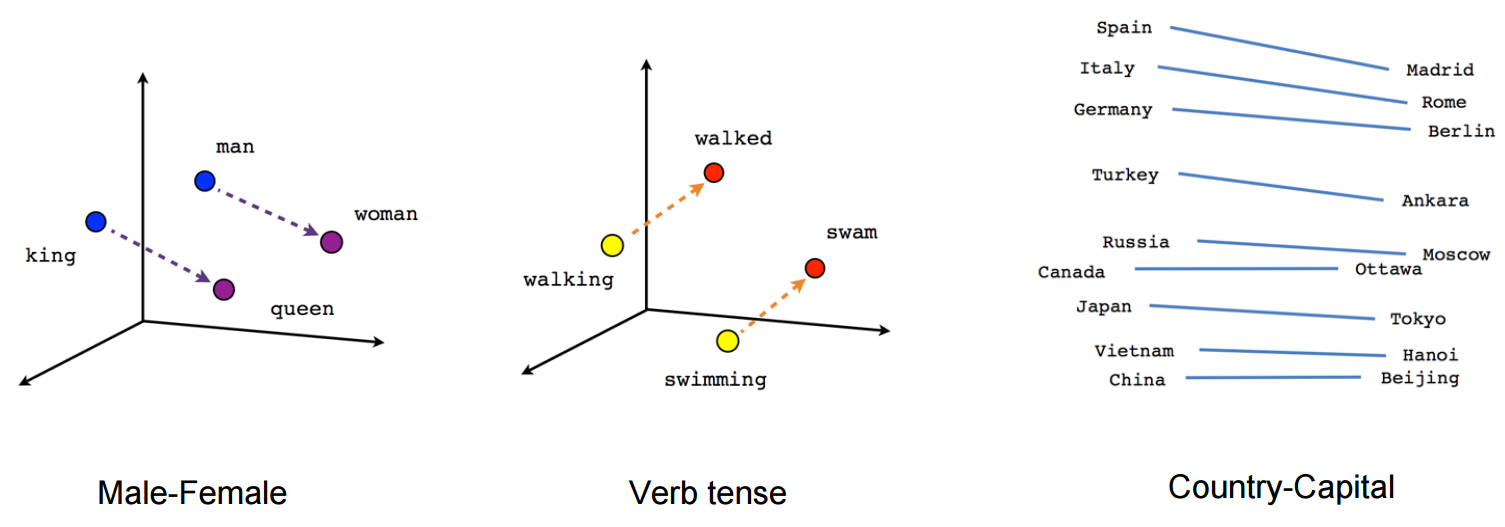
Unlike supervised learning, we don't have labels that tell us 'kitten' = 'cat'. So how do we train a model that will learn the relationship between these two words?
Recap the assumption mentioned before, words with similar meaning tend to appear in similar context. Because 'kitten' and 'cat' appear in similar context, if we can train a model to predict the context of the target word 'cat' and 'kitten' respectively, model should learn a similar representation for both 'kitten' and 'cat' because they produce similar context.
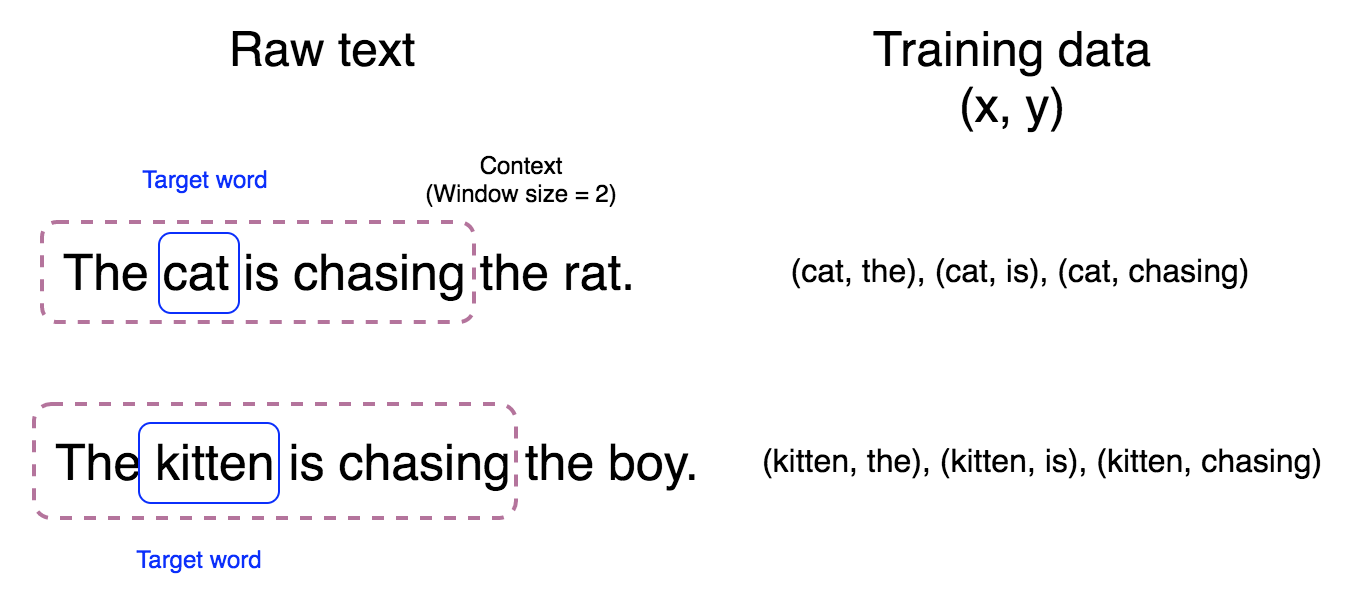
As shown above, for each words like 'cat' in raw text, we will treat them as target word and the words surrounding it as context and construct the training instances (x, y) where x is target word and y is one of the word in context. And the definition of 'context' is decided by the parameter 'window size'.
First, let's load the text data and build the training data in order to train our model.
Libraries¶
# These are all the modules we'll be using later. Make sure you can import them
# before proceeding further.
%matplotlib inline
from __future__ import print_function
import collections
import os
import math
import random
import zipfile
import numpy as np
import tensorflow as tf
# from matplotlib import pylab # use pyplot instead
import matplotlib.pyplot as plt
from six.moves import range
from six.moves.urllib.request import urlretrieve
from sklearn.manifold import TSNE
from tqdm import tnrange
plt.style.use('ggplot')
Raw text data¶
Download / load data¶
Download the data from the source website if necessary. will store the zip file in the 'datasets' subdirectory.
url = 'http://mattmahoney.net/dc/'
def maybe_download(filename, expected_bytes):
"""Download a file into 'datasets' sub-directory
if not present, and make sure it's the right size.
"""
rel_path = 'datasets/{}'.format(filename)
# if file in not found, download it
if not os.path.exists(rel_path):
filename, _ = urlretrieve(url + filename, rel_path)
statinfo = os.stat(rel_path)
if statinfo.st_size == expected_bytes:
print('Found and verified {}. size: {}'.format(rel_path, statinfo.st_size))
else:
print(statinfo.st_size)
raise Exception('Failed to verify ' + filename +
'. Can you get to it with a browser?')
return rel_path
filename = maybe_download('text8.zip', 31344016)
Turn data into words¶
Read the data into a string.
def read_data(filename):
"""Extract the first file enclosed in a zip file as a list of words"""
with zipfile.ZipFile(filename) as f:
data = tf.compat.as_str(f.read(f.namelist()[0])).split()
return data
words = read_data(filename)
print('Data size %d' % len(words))
Look into text corpus¶
The 'data size' above mean how many words we have in the data. That is, there are about 17 millions words!
Let's show some parts of the text data to make some sense of it.
Some phrases which include word 'cat' with window size = '2'.
cats = [' '.join(words[idx - 2: idx + 3]) for idx, word in enumerate(words) if word == 'cat' or word == 'cats']
print('\n'.join(cats[:5]))
del cats
Some phrases which include word 'kitten' with window size = '2'.
kitten = [' '.join(words[idx - 2: idx + 3]) for idx, word in enumerate(words) if word == 'kitten']
print('\n'.join(kitten[:5]))
del kitten
Create training data¶
In order to let TensorFlow make use of the text corpus, we have to transform the text corpus into sequence of numbers. The way to achieve this to build a dictionary which map every word to a unique number and use that dictionary to transform the corpus into number-based data.
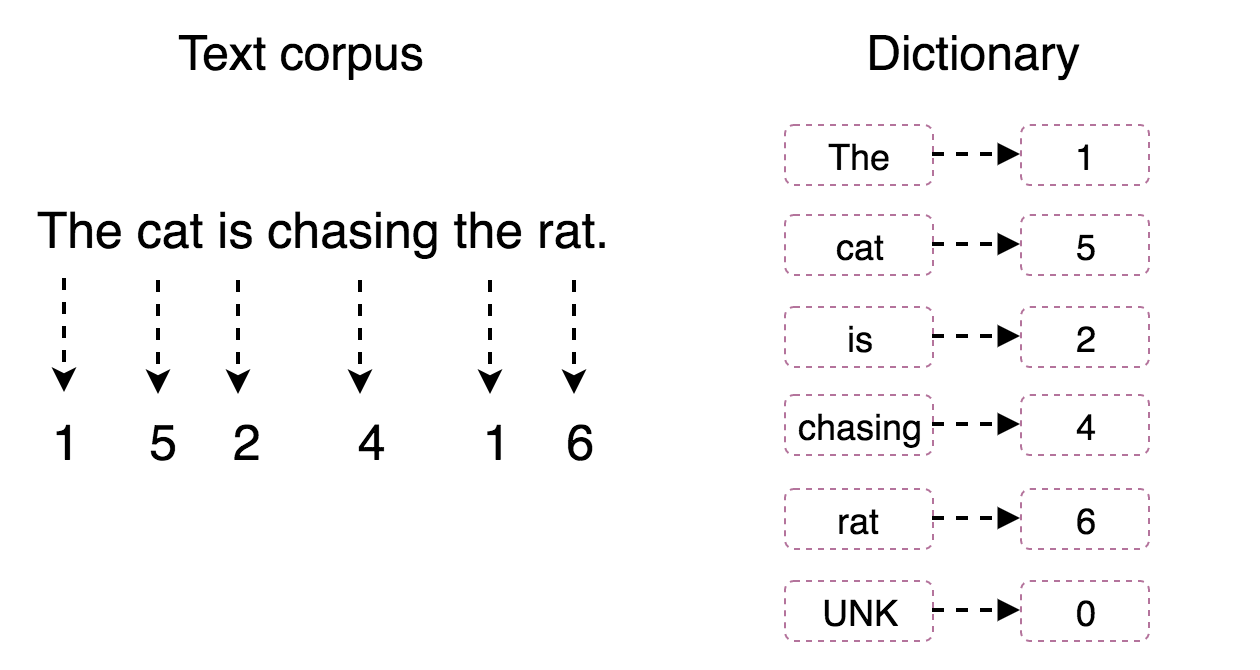
Notice that some rare words may appear very few times in the entire text corpus. We may want to exclude these terms to keep our dictionary in a reasonable size. In order to do this, we will build the dictionary and view these terms as UNK tokens. UNK means unknown word that doesn't exist in the vocabulary set and the default number of a UNK in dictionary is 0 as shown above.
Decide dictionary size¶
Depend on the size of the vocabulary, we will construct a dictionary for top vocabulary_size - 1 common words. For example, if the vocabulary_size = 50000, we will first count the frequencies of every word appeared in the text corpus and put the most common 49,999 terms into our vocabulary and make the rest of words as UNK token. ( thus the 50,000 th term in the vocabulary).
vocabulary_size = 50000
Build dictionary and transform text corpus into sequence of numbers¶
def build_dataset(words):
"""
Build training data for word2vec from a string including
sequences of words divided by spaces.
Parameters:
-----------
words: a string with every word devided by spaces
Returns:
--------
dictionary: a dict with word as key and a unique number(index)
as their value. dictionary[word] = idx
reverse_dictionary: a dict with index as key and the corresponding
word as value. reverse_dictionary[idx] = word
counts: a list contain tuples (word, frequency) sorted descendingly
by frequency while use ('UNK', unk_count) as first tuple.
data: a list contain indices of the original words in the parameters
'words'.
"""
# count term frequencies and choose the most frequent
# terms of vocabulary_size
count = [['UNK', -1]]
count.extend(collections.Counter(words).most_common(vocabulary_size - 1))
dictionary = dict()
# index term by their frequency. while UKN is indexed as 0,
# the term with most frequencies is indexed as 1, the term with 2th frequencies
# is indexed as 2, ...
for word, _ in count:
dictionary[word] = len(dictionary)
# turn the text corpus into a sequence of number where each number is the
# index of the original term in 'dictionary' dict and mark those UNK's number
# as 0 which indicate that they're unknown words
data = list()
unk_count = 0
for word in words:
if word in dictionary:
index = dictionary[word]
else:
index = 0 # dictionary['UNK']
unk_count = unk_count + 1
data.append(index)
# update UNK's count in corpus
count[0][1] = unk_count
# create reverse dict to enable lookup the original word by their index
reverse_dictionary = dict(zip(dictionary.values(), dictionary.keys()))
return data, count, dictionary, reverse_dictionary
data, count, dictionary, reverse_dictionary = build_dataset(words)
print('Most common words (+UNK) in text corpus:\n{}'.format(count[:5]))
See transformed text corpus¶
sample_idx = 1000
print('"{}"\n\nwas transformed into\n\n"{}"'\
.format(' '.join(words[sample_idx: sample_idx + 10]),
' '.join([str(i) for i in data[sample_idx: sample_idx + 10]])))
del words # Hint to reduce memory.
Function to generate a training batch for the skip-gram model.¶
As usual, we will use mini-batch GD to update our model's parameters.
Other than batch_size, we also have to decide the range of context surrounding target word (skip_window) and how many training instances are we going to create from a single (target, context) pair.
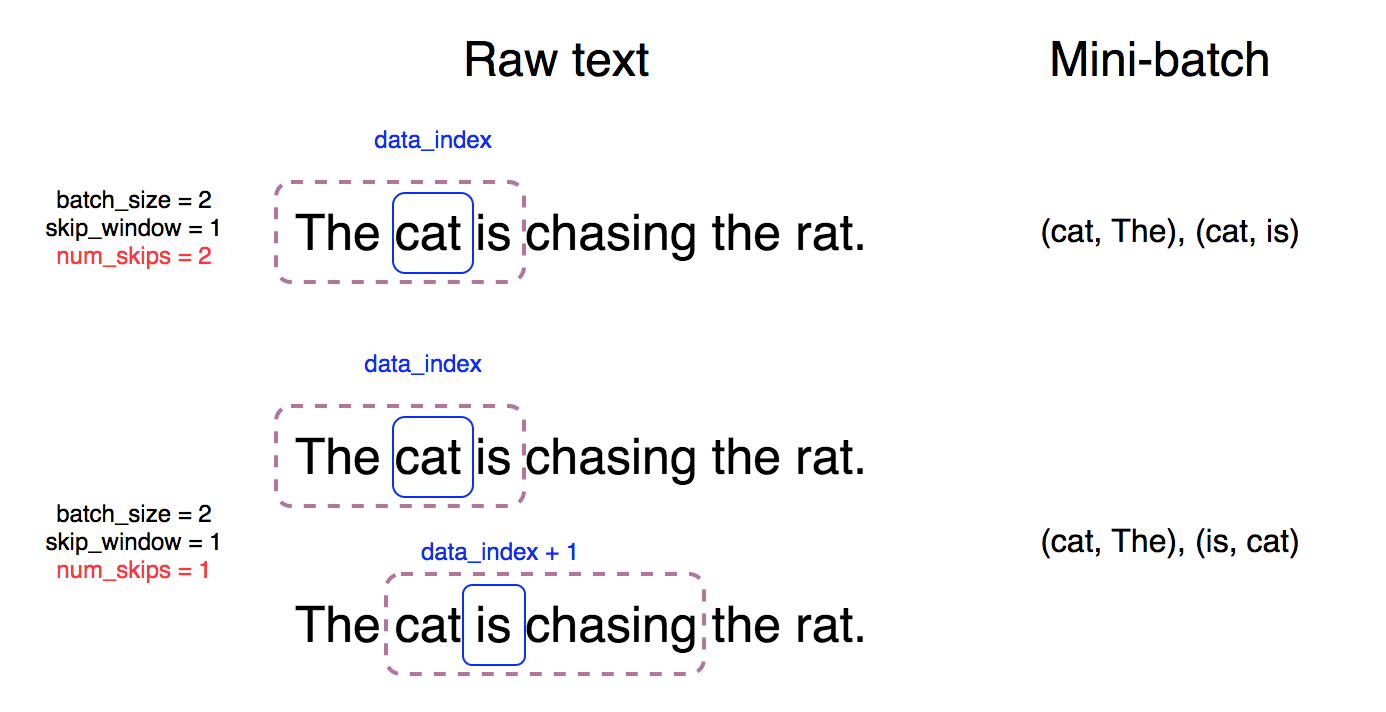
# global variable to randomize mini-batch
data_index = 0
def generate_batch(batch_size, num_skips, skip_window):
"""
Generate a mini-batch containing (target_word, context) pairs
of `batch_size`.
Parameters:
-----------
batch_size: mini_batch's size, typically 16 <= batch_size <= 512
num_skips: how many times to reuse an input/target word to
generate a label.
skip_window: how many words to consider left and right.
Returns:
--------
batch: a list of target words
labels: a list of context words corresponding to target words
in batch
"""
global data_index
assert batch_size % num_skips == 0
assert num_skips <= 2 * skip_window
batch = np.ndarray(shape=(batch_size), dtype=np.int32)
labels = np.ndarray(shape=(batch_size, 1), dtype=np.int32)
# initialize first (target, context) sequence
# = [ skip_window target skip_window ]
span = 2 * skip_window + 1
buffer = collections.deque(maxlen=span)
for _ in range(span):
buffer.append(data[data_index])
data_index = (data_index + 1) % len(data)
# for every target word,
for i in range(batch_size // num_skips):
target = skip_window # target label at the center of the buffer
targets_to_avoid = [skip_window]
# generate #num_skips of training instances
for j in range(num_skips):
# randomly choose a context word that hasn't been chosen yet
# exclude target word by default
while target in targets_to_avoid:
target = random.randint(0, span - 1)
targets_to_avoid.append(target)
batch[i * num_skips + j] = buffer[skip_window]
labels[i * num_skips + j, 0] = buffer[target]
# shift to next (target, context) sequence
buffer.append(data[data_index])
# randomize the start location of every mini-batch
# by adding one offset
data_index = (data_index + 1) % len(data)
return batch, labels
print('data: "{}"'.format(' '.join([reverse_dictionary[di] for di in data[:8]])))
for num_skips, skip_window in [(2, 1), (4, 2)]:
data_index = 0
batch, labels = generate_batch(
batch_size=8, num_skips=num_skips, skip_window=skip_window)
print('\n(target, context) with num_skips = %d and skip_window = %d:' % (num_skips,
skip_window))
print('{}'.format('\n'.join(
[str((reverse_dictionary[t], reverse_dictionary[c])) \
for t, c in zip(batch, labels.reshape(8))])))
Word2Vec skip-gram model.¶
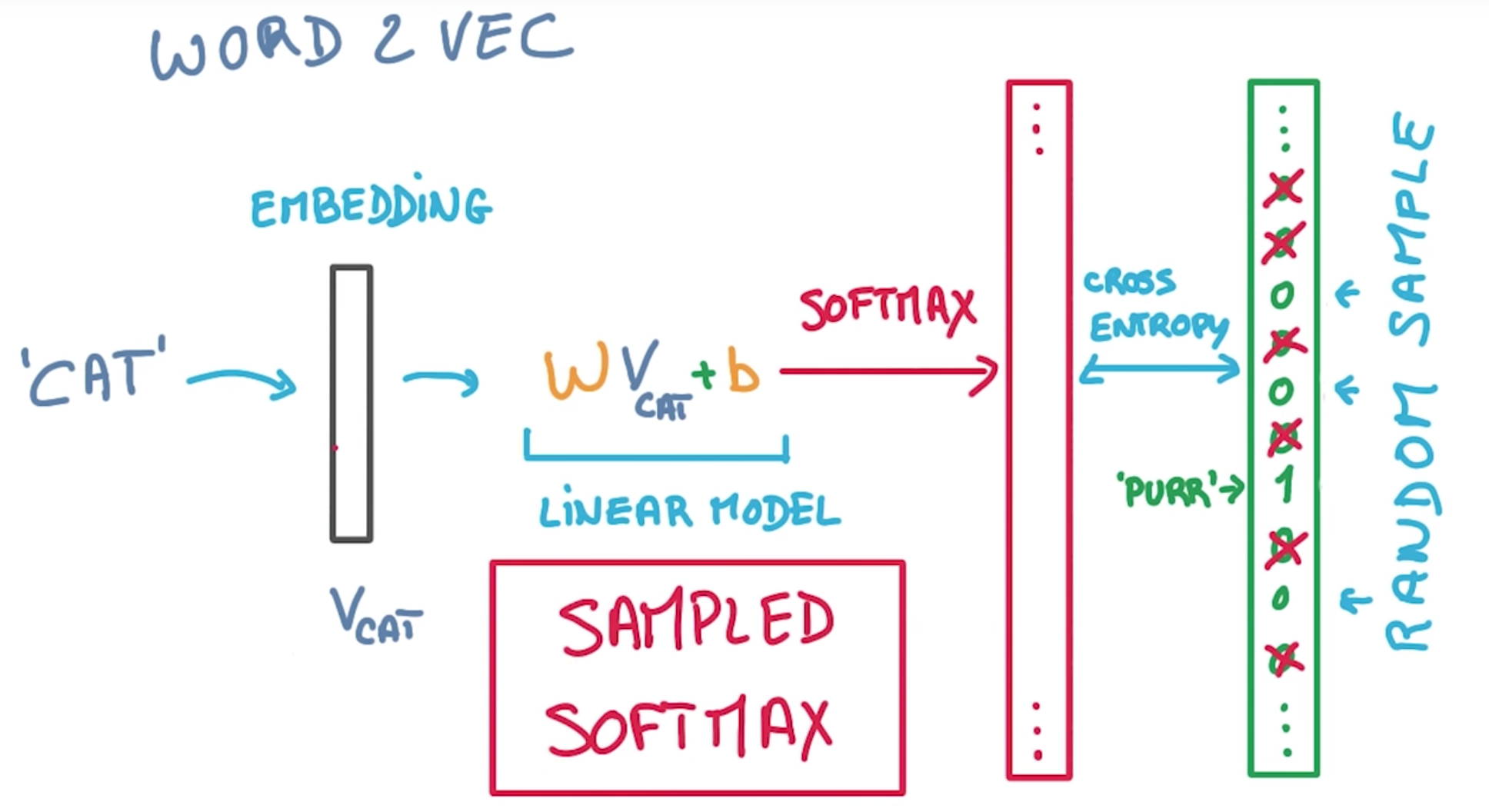
Computation graph¶
batch_size = 128
embedding_size = 128 # Dimension of the embedding vector.
skip_window = 1 # How many words to consider left and right.
num_skips = 2 # How many times to reuse an input to generate a label.
# We pick a random validation set to sample nearest neighbors. here we limit the
# validation samples to the words that have a low numeric ID, which by
# construction are also the most frequent.
valid_size = 16 # Random set of words to evaluate similarity on.
valid_window = 100 # Only pick dev samples in the head of the distribution.
valid_examples = np.array(random.sample(range(valid_window), valid_size))
num_sampled = 64 # Number of negative examples to sample.
graph = tf.Graph()
with graph.as_default(), tf.device('/cpu:0'):
# Input data.
train_dataset = tf.placeholder(tf.int32, shape=[batch_size])
train_labels = tf.placeholder(tf.int32, shape=[batch_size, 1])
valid_dataset = tf.constant(valid_examples, dtype=tf.int32)
# Variables.
embeddings = tf.Variable(
tf.random_uniform([vocabulary_size, embedding_size], -1.0, 1.0))
softmax_weights = tf.Variable(
tf.truncated_normal(
[vocabulary_size, embedding_size],
stddev=1.0 / math.sqrt(embedding_size)))
softmax_biases = tf.Variable(tf.zeros([vocabulary_size]))
# Model.
# Look up embeddings for inputs.
embed = tf.nn.embedding_lookup(embeddings, train_dataset)
# Compute the softmax loss, using a sample of the negative labels each time.
# this is how we speed up training phase
loss = tf.reduce_mean(
tf.nn.sampled_softmax_loss(
weights=softmax_weights,
biases=softmax_biases,
inputs=embed,
labels=train_labels,
num_sampled=num_sampled,
num_classes=vocabulary_size))
# Optimizer.
# Note: The optimizer will optimize the softmax_weights AND the embeddings.
# This is because the embeddings are defined as a variable quantity and the
# optimizer's `minimize` method will by default modify all variable quantities
# that contribute to the tensor it is passed.
# See docs on `tf.train.Optimizer.minimize()` for more details.
optimizer = tf.train.AdagradOptimizer(1.0).minimize(loss)
# Compute the similarity between minibatch examples and all embeddings.
# We use the cosine distance:
norm = tf.sqrt(tf.reduce_sum(tf.square(embeddings), 1, keep_dims=True))
normalized_embeddings = embeddings / norm
valid_embeddings = tf.nn.embedding_lookup(normalized_embeddings,
valid_dataset)
similarity = tf.matmul(valid_embeddings,
tf.transpose(normalized_embeddings))
Train the model¶
num_steps = 100001
with tf.Session(graph=graph) as session:
tf.global_variables_initializer().run()
print('Initialized')
average_loss = 0
for step in tnrange(num_steps):
batch_data, batch_labels = generate_batch(batch_size, num_skips,
skip_window)
feed_dict = {train_dataset: batch_data, train_labels: batch_labels}
_, l = session.run([optimizer, loss], feed_dict=feed_dict)
average_loss += l
if step % 2000 == 0:
if step > 0:
average_loss = average_loss / 2000
# The average loss is an estimate of the loss over the last 2000 batches.
print('Average loss at step %d: %f' % (step, average_loss))
average_loss = 0
# note that this is expensive (~20% slowdown if computed every 500 steps)
if step % 10000 == 0:
sim = similarity.eval()
for i in range(valid_size):
valid_word = reverse_dictionary[valid_examples[i]]
top_k = 8 # number of nearest neighbors
nearest = (-sim[i, :]).argsort()[1:top_k + 1]
log = 'Nearest to %s:' % valid_word
for k in range(top_k):
close_word = reverse_dictionary[nearest[k]]
log = '%s %s,' % (log, close_word)
print(log)
final_embeddings = normalized_embeddings.eval()
Transform embedding into 2D using t-SNE¶
final_embeddings.shape
%%time
num_points = 400
tsne = TSNE(perplexity=30, n_components=2, init='pca', n_iter=5000, method='exact')
two_d_embeddings = tsne.fit_transform(final_embeddings[1:num_points+1, :])
Visualize result¶
def plot(embeddings, labels):
assert embeddings.shape[0] >= len(labels), 'More labels than embeddings'
plt.figure(figsize=(15, 15)) # in inches
for i, label in enumerate(labels):
x, y = embeddings[i, :]
plt.scatter(x, y)
plt.annotate(
label,
xy=(x, y),
xytext=(5, 2),
textcoords='offset points',
ha='right',
va='bottom')
plt.show()
words = [reverse_dictionary[i] for i in range(1, num_points + 1)]
plot(two_d_embeddings, words)
Todo¶
CBOW
An alternative to skip-gram is another Word2Vec model called CBOW (Continuous Bag of Words). In the CBOW model, instead of predicting a context word from a word vector, you predict a word from the sum of all the word vectors in its context. Implement and evaluate a CBOW model trained on the text8 dataset.
References¶
- Original jupyter notebook from the Udacity MOOC course: Deep learning by Google.
- TensorFlow word2vec tutorial
- http://mccormickml.com/2016/04/19/word2vec-tutorial-the-skip-gram-model/
跟資料科學相關的最新文章直接送到家。 只要加入訂閱名單,當新文章出爐時, 你將能馬上收到通知
